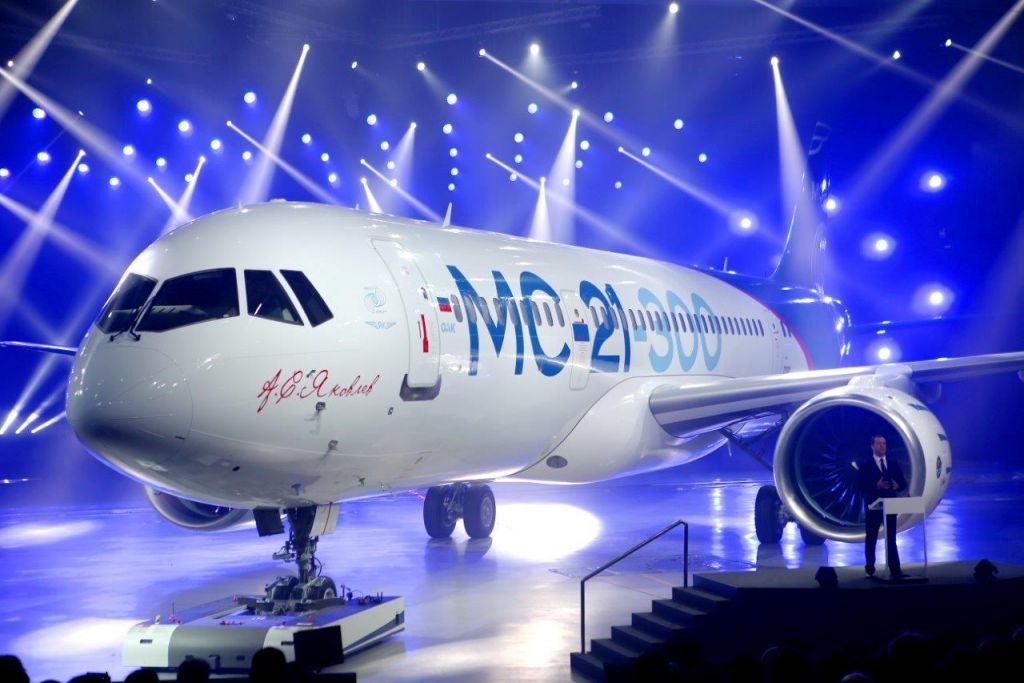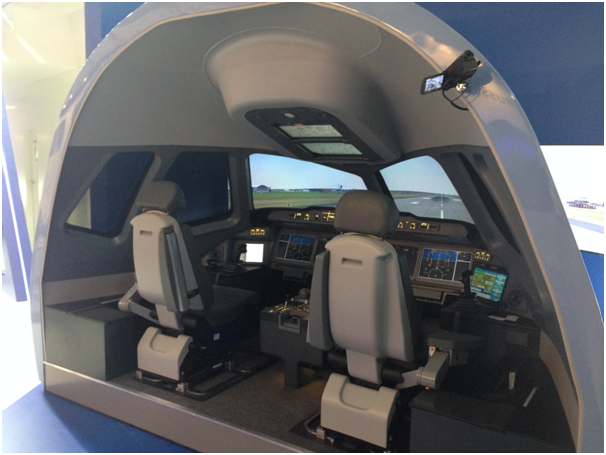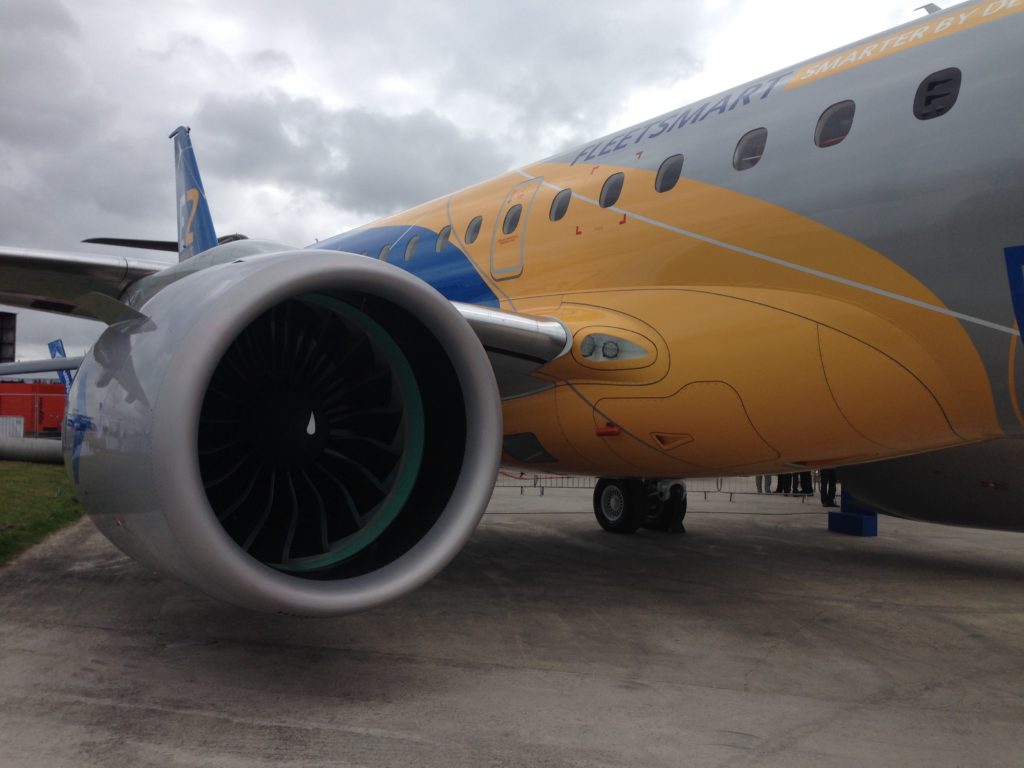Leeham News and Analysis
There's more to real news than a news release.
Irkut MC-21; we look at the MC-21-300, Part 2.
By Bjorn Fehrm
Subscription required.
Introduction
August 01, 2016, ©. Leeham Co: After having found the nearest competitor to the Irkut MC-21-300 as the Boeing 737 MAX 9 in our first article, we now go deeper in the comparison of the two aircraft.
In the first article, we found that the aircraft have almost identical cabin dimensions. Now we will look at other areas like airframe dimensions, weights and data which dictate overall performance.
Summary:
- The MC-21 has cabin dimensions which are very close to the 737 MAX 9.
- The nominal two class seating by Irkut is lower than the MAX 9. We have assumed that this will increase during the lifetime of the MC-21.
- We also compare other data between the MC-21-300 and the MAX 9, such as weights, wetted areas and effective wingspans to see if these are similar as well. In the end these dictate the aircraft’s efficiency together with the engines.
IRKUT MC-21; we look at the MC21-300.
By Bjorn Fehrm
Subscription required.
Introduction
July 28, 2016, ©. Leeham Co: In February we did a first analysis of the new Irkut MC-21 single aisle aircraft that Russia is developing. We found that the aircraft has its own profile; it’s not a copy of a Western design. Irkut is the company within Russia’s United Aircraft group which is developing MC-21 (or rather, its design bureau, Yakovlev, is). Irkut has also gone its own way in sizing the aircraft.
In our February analysis, we found that the first aircraft being developed, the MC-21-300, is larger than both the Airbus A320 and Boeing 737 MAX 8, the present top sellers in the single aisle market. At the time, we decided to analyze the aircraft which was closest to those two in size, MC-21-200, which is the second variant in development. We will now look at the larger MC-21-300 (Figure 1), the aircraft which rolled out in June and which will fly early next year.
Summary:
- The MC-21 has its own profile; it is not a copy of a Western aircraft. It has a wider cabin than the A320 and a higher capacity in its base variant, the MC-21-300.
- The MC-21-300 is smaller than an A321. It most closely resembles a Boeing 737 MAX 9 in size. We will therefore conduct the analysis of the MC-21-300 by comparing it to the largest Boeing MAX variant.
Bjorn’s Corner: Flight simulators
22 July 2016, ©. Leeham Co: Last week at the Farnborough Air Show I had the chance to try three flight simulators: The MC-21 airliner simulator, the SAAB Gripen fighter simulator and a special simulator for testing some new 3D synthetic vision ideas for a future avionics system. I’ve now tried some dozen different aircraft simulators of different generations, not counting the PC-based ones.
The simulators were different types. Some were fixed with displays that wrapped around and covered the peripheral vision like the Irkut MC-21 and SAAB Gripen ones. Others were full motion with complete surround vision display like the Airbus A350 simulator that I trained in ahead of flying A350 MSN002 last April, Figure 1. A third type were closed full motion simulators that lacked a vision system.
Compared with the very advanced Airbus simulator, I was surprised how realistic it felt with the simpler fixed simulators I tried last week. It made me wonder why.
Flying the Irkut MC-21 simulator
By Bjorn Fehrm
21July 2016, ©. Leeham Co:Russia’s United Aircraft Irkut division had the good taste to bring a fully functional MC-21 simulator to Farnborough Air Show. I managed to get an hour of take-offs and landings during the show’s early hours on Thursday.
The simulator consists of a fixed cockpit, Figure 1, with a panoramic screen giving a terrain view out of the cockpit windows. The terrain model was of good quality and the feeling of flying a good non-moving simulator was there.
The simulator was especially conceived for exhibitions but it didn’t seem to be less functional because of that. Flight laws should be the same as the full MC-21 simulators but the implementation team is separate from the team which is making the flight crew training simulators. I was accompanied in the Sim by Sergey, one of the software programmers of the simulator. He was interested in my impressions, as it was still relatively early days in the simulator’s design.
IRKUT MC-21 analysis, Part 4. Performance with PD-14
By Bjorn Fehrm
Subscription required.
Introduction
March. 14, 2016, ©. Leeham Co: In three articles we have been looking at the new Russian single aisle aircraft, Irkut MC-21, from United Aircraft and the new Russian engine that is being developed for the aircraft, the PD-14.
The PD-14, which is offered as an alternative to the base engine for the aircraft, the Pratt & Whtiney PW1400G, was analysed in our Part 3 article. We now mount the engine on the MC-21 and explore the difference in performance compared to the base engine.
Summary:
- The PD-14, which is a new engine designed by the Aviadvigatel company, is a clear step forward for the Russian turbofan industry.
- In our analysis in Part 3, we could see that it has a classical direct drive construction with a good level of technology in several parts.
- Weight and installation dimension are similar to the competition but efficiency is a bit behind.
- We now explore the performance of the MC-21 with the Russian engine.
MOMentum appears to be slowing for new Boeing airplane
Subscription required
Introduction

Model design and paint by Camil Valiquette. Photo via Google.
March 10, 2016, © Leeham Co.: MOMentum for the Middle of the Market aircraft seems to be slowing from last year, as potential buyers and Boeing struggle to define an aircraft that would be affordable to build, affordable to buy and fulfill different mission requirements for capacity or range.
Meantime, Airbus is content to watch Boeing’s predicament, secure in what it believes is the winning strategy.
Summary
- Attendees at the ISTAT conference last week had no consensus about what the airplane should be, when or even if Boeing should launch the airplane.
- Some customers want range, others want capacity.
- “757 replacement?” Not really.
IRKUT MC-21 analysis, Part 3. The Russian engine alternative
By Bjorn Fehrm
Subscription required.
Introduction
Feb. 29, 2016, ©. Leeham Co: In two articles we have been looking at the new Russian single-aisle aircraft, Irkut MC-21from United Aircraft. Now it’s time to analyze the new Russian engine, PD-14, which is offered as an alternative to the base engine for the aircraft, the Pratt & Whitney PW1400G. 
Summary:
- The PD-14 is a new engine designed by the Aviadvigatel company, a merger of the Soloviev design bureau with the Perm engine company.
- PD-14 is a modern 31klbf design aimed at several Russian aircraft, the first being the MC-21.
- The technology and performance of the PD-14 engine are approaching its Western counterparts, Pratt & Whitney PW1400G and LEAP-1A, but not quite reaching their level. We go through where it differs. Read more
IRKUT MC-21 analysis, Part 2
By Bjorn Fehrm
Subscription required.
Introduction
Feb. 24, 2016, ©. Leeham Co: Two weeks ago we started our analysis of the new Russian single aisle aircraft, United Aircraft’s Irkut MC-21. We looked at key design features and compared these to the Airbus A320.
We also analyzed the passenger capacity where we found that the model which will start flight testing, the MC-21-300, has a capacity between the A320 and the A321. The closest aircraft in capacity and performance in the MC-21 lineup versus the competition would be the MC-21-200 and A320neo.
We have therefore decided to do our efficiency analysis between these variants.
Summary:
- The MC-21 has a wider fuselage than the A320. This is a positive as it allows passengers to pass each other in the aisle of the cabin.
- The drawback of the wider fuselage is a bit higher aircraft drag.
- Coupled with a lower wing aspect ratio, the lighter MC-21 cannot open a fuel consumption advantage over the A320neo, despite being a more modern design.
Irkut MC-21, first analysis
By Bjorn Fehrm
Subscription required.
Introduction
Feb. 08, 2016, © Leeham Co: We recently covered China’s COMAC C919 and now the time has come to the other new narrow body aircraft from the old Communist bloc, the Russian MC-21.
The aircraft is called Irkut MC-21. Not many have heard of Irkut, so the first reaction is that this aircraft is made by a new Russian aircraft firm. The change is that United Aircraft (the Russian aircraft industry holding company) this time called the aircraft after its manufacturing company and not the design bureau, Yakovlev, that Irkut acquired in 2004. There are discussions to change back to the project’s original name Yakovlev 242 once certification is done.
When we looked at the first civil airliner that the Russian federation designed after the fall of Soviet Union, the Sukhoi Superjet 100, we found a well designed aircraft equipped with Western system. The MC-21 follows the same lines, but has more Russian technological development. It is therefore well worth a look.
Summary:
- The MC-21 has its own profile. It is not a copy of a Western aircraft. It has a wider cabin than the A320, a wing which allows a higher cruise speed and a higher capacity in its base variant, the MC-21-300.
- To make a meaningful comparison between the MC-21 and established aircraft, we have chosen to compare the MC-21-200 with the Airbus A320neo, as the MC-21-300 is larger than the A320neo but smaller than an A321neo. The MC-21-200 is closer in size to an A320neo. Read more







